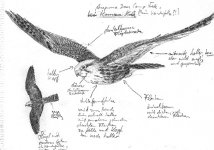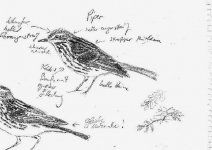Joern Lehmhus
Well-known member
Hi all, While I was searching some different things, I came across an old sketch pad from my nepal tour 12 years ago, which I thought I had lost years ago.
Bird id was difficult for me then because I had brought no good bird book with me and did not get a good one there.
But now with the old notes and sketches it is perhaps possible to get some more species identified than I did manage then?
The travels were from mid-September to mid-October 1992 in the Chitwan, in the Anapurna region (we did make the Annapurna base camp trek from Pokhara), and in the Kathmandu valley.
So here come the first 3 descriptions:
1.A group of about 15 starling-sized or thrush-sized birds in the Annapurna base camp area (about 4200m), seen from quite a distance: some a beautiful dark blue with black wings and tail, others brown speckled , wings darker than body and with a small white patch (in the middle of the wing when closed) they where hopping on the ground between rocks and on short grass meadow.
2. A dark brown falcon with a light beige/sandcoloured crown, also quite dark flanks , with dark blotchy spots- the overall appearance was very dark, except the head and upper part of breast and undertail coverts, the "beard stripe" on the head was dark but thin. Size about the size of a peregrine.also seen on that Annapurna base camp treck, but much lower (hight not noted, near Kumru Kola)
3. An all grey thrush with a lighter gorge with a thin dark stripe beginning from the bill, bill was dirty orange-horn coloured- seen near the village Bamboo
Hope somebody can help-
perhaps somebody can also recommend a book on the birds of the region? I´m thinking to go there again in the next years...
Thanks, Jörn
Bird id was difficult for me then because I had brought no good bird book with me and did not get a good one there.
But now with the old notes and sketches it is perhaps possible to get some more species identified than I did manage then?
The travels were from mid-September to mid-October 1992 in the Chitwan, in the Anapurna region (we did make the Annapurna base camp trek from Pokhara), and in the Kathmandu valley.
So here come the first 3 descriptions:
1.A group of about 15 starling-sized or thrush-sized birds in the Annapurna base camp area (about 4200m), seen from quite a distance: some a beautiful dark blue with black wings and tail, others brown speckled , wings darker than body and with a small white patch (in the middle of the wing when closed) they where hopping on the ground between rocks and on short grass meadow.
2. A dark brown falcon with a light beige/sandcoloured crown, also quite dark flanks , with dark blotchy spots- the overall appearance was very dark, except the head and upper part of breast and undertail coverts, the "beard stripe" on the head was dark but thin. Size about the size of a peregrine.also seen on that Annapurna base camp treck, but much lower (hight not noted, near Kumru Kola)
3. An all grey thrush with a lighter gorge with a thin dark stripe beginning from the bill, bill was dirty orange-horn coloured- seen near the village Bamboo
Hope somebody can help-
perhaps somebody can also recommend a book on the birds of the region? I´m thinking to go there again in the next years...
Thanks, Jörn





